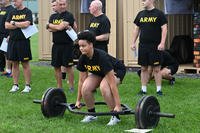Life has a way of putting our bodies into a poor posture. From sitting all day at a desk, driving several hours or looking down at your phone for long periods of time, everything tends to have us hunched over and bent over from the hips and lower back. If you are having pain in your lower back from too much sitting, pain in your neck from too much time on the smart phone or slouching forward at the shoulders, you have a postural imbalance.
An imbalance is a bad habit. Our body gets used to a certain position, and it will want to stay in that position, making simple activities like stretching and walking painful. As with anything, we typically have to stop a bad habit and start a good one to see success.
Correcting your posture is no different. Think of it this way: You have to start stretching one muscle group and strengthening the opposing muscle group in order to fix any imbalance you may have.
The most common imbalances in the body are front and back side imbalances. Whether the chest and rear shoulder/upper back, abdominal muscles and lower back, front and back of the hips, or thigh and hamstrings of the legs, these combinations of muscles need a mix of stretching more and exercising more.
These imbalances do not just plague the sedentary. They can wreak havoc on highly active people as well if their programming is not addressing opposing muscle groups. Take, for instance, the guy who only goes to the gym to bench-press or the young teen who only does push-ups when his interest in fitness grows. Both are building imbalances in their chest, front deltoids and triceps by neglecting the rear deltoids, rhomboids and other upper-back muscles that oppose the chest pushing movements.
Here are some exercises and some other tips:
Fixing internal rotation: The forward rounding of the shoulders, forward tilting of the head and neck, and sunken-in chest result from us sitting and driving in this position. If we exercise only the front side of our upper body, we will exacerbate this position. Do more stretching of the chest and shoulders, but also do more flexing (strengthening) of the rear shoulder and upper-back muscles with exercises like reverse push-ups, reverse flies or TRX wide rows, and dumbbell or TRX rows.
Tip: If you are exercising regularly, make sure you are pulling as much as you are pushing. Pull-ups make for a great natural pulling exercise. However, the row will directly balance out bench press and push-up imbalances that are pretty common for those beginning fitness.
Muscles to stretch more: Stretching and foam rolling (or massage) are great ways to loosen tight muscles grown used to sedentary living. Warm up the body with a short walk or bike ride to get the blood flowing and then lightly stretch the chest muscles, back of the neck to trapezius muscles, front of the hips (hip flexors) and the back of the legs (hamstrings). Focus on the spine/hips first, then continue down into the legs and up into the shoulders and chest.
Muscles to strengthen regularly: Keep doing your normal routine, but remember each muscle group you work has an opposing set of muscles that also need to be exercised. Add in more exercises to your daily routine to strengthen the core (upper back, lower back and abdominal region).
Notice the core is not just the stomach muscles. If you do a lot of abdominal exercises or are training to pass sit-up tests, make sure you balance those exercises of the lower front torso with the opposing muscles of the lower back. Plank poses and swimmers are excellent exercises to work the back side of the core.
Hip imbalances: The hips are critical to our posture. Loosen the hips with thigh stretches but push the hips forward to stretch the hip flexors, too. To exercise the hips, try hip thrusts, dirty dogs and hip rollers. Also continue stretching the glutes, iliotibial band, stomach, lower back and hamstrings (all can be found in the lower back plan below).
The Lower Back Plan is a free, downloadable and has stretches for the legs, hips, torso and chest, as well as exercises for the upper back, lower back and abdominals. Most people use the lower back plan as a cooldown after a workout, with many of the upper- and lower-back exercises and all of the stretches. Some also do the charts in full and create a challenging full-core workout as well.
Stew Smith is a former Navy SEAL and fitness author certified as a Strength and Conditioning Specialist (CSCS) with the National Strength and Conditioning Association. Visit his Fitness eBook store if you’re looking to start a workout program to create a healthy lifestyle. Send your fitness questions to stew@stewsmith.com.
Want to Learn More About Military Life?
Whether you're thinking of joining the military, looking for fitness and basic training tips, or keeping up with military life and benefits, Military.com has you covered. Subscribe to Military.com to have military news, updates and resources delivered directly to your inbox.


















